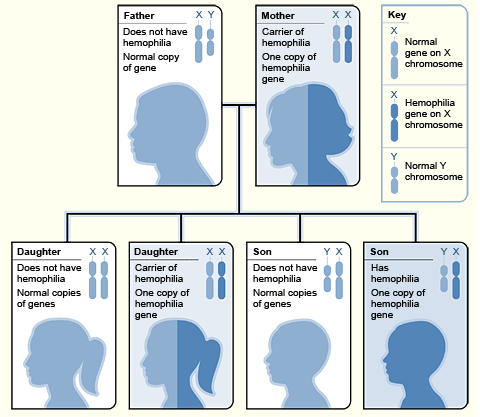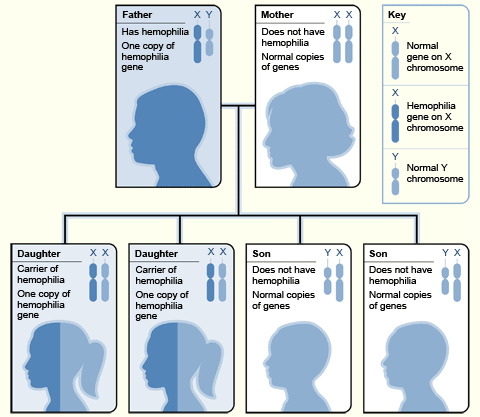What Causes Hemophilia?
If you have inherited hemophilia, you’re born
with the condition. It’s caused by a defect in one of the genes that
determine how the body makes blood clotting factors VIII or IX. These genes are
located on the X chromosomes (KRO-muh-somz).
Chromosomes come in pairs. Females have two X
chromosomes, while males have one X and one Y chromosome. Only the X chromosome
carries the genes related to clotting factors.
A male who has the abnormal gene on his X chromosome
will have hemophilia. A female must have the abnormal gene on both of her X
chromosomes to have hemophilia; this is very rare.
A female is a “carrier” of hemophilia if
she has the abnormal gene on one of her X chromosomes. Even though she
doesn’t have the condition, she can pass the gene on to her children.
Below are two examples of how the hemophilia gene is
inherited.
Inheritance Pattern for
Hemophilia—Example 1

The diagram shows one example of
how the hemophilia gene is inherited. In this example, the father doesn't have
hemophillia (that is, he has two normal chromosomes—X and Y). The mother
is a carrier of hemophilia (that is, she has one abnormal X chromosome and one
normal X chromosome). Each daughter has a 50 percent chance of inheriting the
abnormal gene from her mother and being a carrier. Each son has a 50 percent
chance of inheriting the abnormal gene from his mother and having hemophilia.
Inheritance Pattern
for Hemophilia—Example 2

The diagram shows one example of how
the hemophilia gene is inherited. In this example, the father has hemophilia
(that is, his X chromosome is abnormal). The mother isn’t a carrier of
hemophilia (that is, she has two normal X chromosomes). Each daughter will
inherit the abnormal gene from her father and be a carrier. None of the sons
will inherit the abnormal gene from their father, and, therefore, none will
have hemophilia.
Females who are carriers usually have enough
clotting factors from their one normal X chromosome to prevent serious bleeding
problems.
Very rarely, a girl is born with hemophilia. This
can happen if her father has hemophilia and her mother is a carrier.
Some males with the disorder are born to mothers who
aren’t carriers. In these cases, a mutation (random change) occurs in the
gene as it is passed to the child. |

